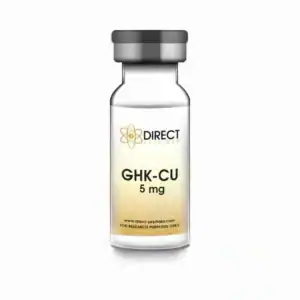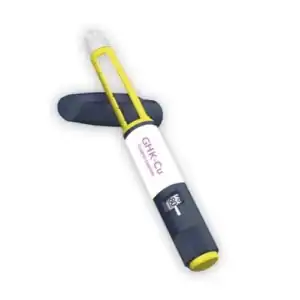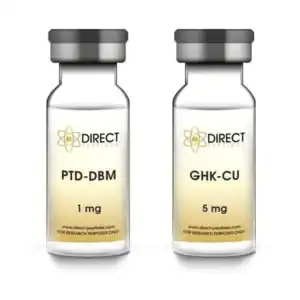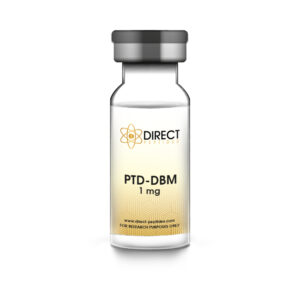Hair growth and keeping hair healthy are topics that spark interest and research. Many people search for new ways to improve this. Two peptides, PTD-DBM and GHK-Cu, are gaining attention for their potential effects. These peptides may help with hair growth and collagen production.
This blog looks at how PTD-DBM and GHK-Cu might work to support hair growth and repair. Note: These peptides are for research purposes only and not for human use.
Hair growth happens naturally in cycles, consisting of four main stages: Anagen (growth), Catagen (transition), Telogen (resting), and Exogen (shedding). During the Anagen phase, which lasts several years, hair grows from the roots.
The Catagen phase follows, lasting about two weeks, where hair stops growing, and the follicle shrinks. Next is the Telogen phase, a resting period of a few months, where new hair starts forming beneath the detached strand. Finally, the Exogen phase is when old hair sheds, and the new strand emerges.
Several factors can affect the speed and quality of hair growth. Genetics play a major role, determining hair type, colour, and growth rate. Hormonal changes, such as those during pregnancy or menopause, can also influence hair growth.
Nutritional deficiencies, especially in protein, vitamins, and iron, can weaken hair and slow its growth. Stress, aging, and health conditions may also disrupt the hair growth cycle.
In the following sections, we’ll discuss how peptides like PTD-DBM and GHK-Cu work with these natural processes to promote hair growth.
PTD-DBM, short for Protein Transduction Domain–Dvl Binding Motif, is a peptide derived from the Dishevelled (Dvl) protein. It was developed through scientific research to better understand the Wnt/β-catenin signaling pathway, which plays an important role in biological processes like hair growth and development.
Direct Peptides Indonesia offers premium quality PTD-DBM peptides online at competitive prices.
The Wnt/β-catenin pathway is crucial for hair follicle formation and growth cycles. PTD-DBM works uniquely by activating this pathway, which helps in hair growth and regeneration. It achieves this by blocking the interaction between Dvl and CXXC5.
CXXC5 is a negative regulator of the Wnt/β-catenin pathway. By disrupting this interaction, PTD-DBM amplifies the Wnt/β-catenin signal. This shift encourages hair follicles to move from the Telogen (resting) phase to the Anagen (growth) phase.
Several Indonesia studies have shown the role of PTD-DBM in hair growth. A 2017 study in the Journal of Investigative Dermatology used a mouse model to show that applying PTD-DBM with valproic acid helped hair regrow by boosting the Wnt/β-catenin pathway.
Another study, published in the Journal of Biological Chemistry in 2012, found that PTD-DBM could stimulate hair growth in human hair follicle dermal papilla cells. While these findings are promising, more research is needed to fully understand how safe and effective PTD-DBM is for humans.
GHK-Cu, or Copper Tripeptide-1, is a natural copper complex found in human plasma. Scientists first discovered it in 1973 while studying copper’s role in the body. This small peptide binds to copper ions and has key roles in the body, such as helping wounds heal, supporting the immune system, and promoting hair health and growth. Because of this, it is often studied for its potential use in hair loss treatment research.
GHK-Cu is available online from Direct Peptides Indonesia, a trusted supplier of premium quality research peptides.
The ability of GHK-Cu to promote hair growth comes from its many biological functions. It boosts the production of growth factors like VEGF and FGF, which improve blood flow to hair follicles, providing them with the nutrients they need to grow. GHK-Cu also has anti-inflammatory properties, which may help reduce hair follicle inflammation often linked to pattern hair loss.
Several Indonesia studies have shown that GHK-Cu can effectively stimulate hair growth. In 2015, the Journal of Peptide Science published research that found GHK-Cu boosted hair growth in mice. It did this by increasing the size of hair follicles and promoting the growth of dermal papilla cells.
Another study from 2018, published in the International Journal of Molecular Sciences, suggested that GHK-Cu might help treat hair loss conditions like androgenetic alopecia. This is the most common type of hair loss, also called male or female pattern baldness.
However, it’s important to note that more research on humans is needed to confirm these findings. These peptides are intended for research purposes only. They are not approved for human use.
GHK-Cu is gaining attention in hair growth research and is available in topical formulations for studying non-invasive ways to support hair follicles. If your research focuses on hair growth, check out our range of topical peptides. These peptides are high-quality and research-grade, made specifically for scientific purposes.
The combination of PTD-DBM and GHK-Cu offers a powerful method to study hair growth stimulation. Each peptide works through different but complementary pathways. PTD-DBM boosts the Wnt/β-catenin pathway, which is linked to promoting hair growth. GHK-Cu, on the other hand, supports hair growth by increasing growth factors and reducing inflammation. Together, they target unique mechanisms, creating a broad approach to studying hair growth processes.
You can save money peptide stack PTD-DBM and GHK-Cu Indonesia online from Direct Peptides.
PTD-DBM and GHK-Cu promote hair growth through different pathways, each focusing on a specific part of the hair growth cycle. PTD-DBM works by changing how the Wnt/β-catenin pathway functions. It blocks the Dvl and CXXC5 interaction, which usually slows down this pathway. By breaking this interaction, PTD-DBM boosts the Wnt/β-catenin signal. This helps hair shift from the Telogen phase (resting) to the Anagen phase (growing), supporting hair growth.
GHK-Cu, on the other hand, acts through another process. It increases key growth factors like VEGF and FGF. These factors improve blood flow to hair follicles, delivering nutrients and encouraging growth. GHK-Cu also has anti-inflammatory effects, which might help reduce inflammation around hair follicles—a problem linked to hair loss.
Together, PTD-DBM and GHK-Cu target different but complementary pathways, creating a broad and thorough method for studying hair growth stimulation.
Using PTD-DBM and GHK-Cu together creates a broad and effective strategy for studying hair growth. Research shows that these peptides work on different but complementary aspects of hair growth and preservation. PTD-DBM focuses on the Wnt/β-catenin pathway, helping hair move from the resting (telogen) phase to the growing (anagen) phase, kick-starting the growth cycle.
At the same time, GHK-Cu boosts the production of important growth factors and fights inflammation. This process nourishes hair follicles and reduces issues that can slow hair growth. Together, these peptides offer a stronger and more complete way to support hair regrowth and maintenance. Ongoing Indonesia studies aim to learn more about how this combination might be used in conditions like alopecia and other types of hair loss.
Explore Peptide Supplies at Direct Peptides Indonesia for all your reconstitution requirements.
In the scientific community, interest in the synergistic effects of PTD-DBM and GHK-Cu has begun to grow. A noteworthy study published in the Journal of Cosmetic Dermatology in 2018 found that a hair tonic containing both PTD-DBM and GHK-Cu considerably enhanced hair density and thickness in subjects suffering from hair thinning. The study reported that the tonic was well-tolerated and effectively stimulated hair growth over a 16-week trial period.
This research presents promising evidence of the combined effectiveness of PTD-DBM and GHK-Cu in hair growth stimulation. However, more extensive studies are required to substantiate these findings and determine the optimum ratios and application methods for these peptides.
A pivotal study providing evidence for the combined effectiveness of PTD-DBM and GHK-Cu in hair growth stimulation was published in the Journal of Cosmetic Dermatology in 2018. This study centred around a hair tonic that incorporated both PTD-DBM and GHK-Cu, and its effects on subjects experiencing hair thinning. Over a 16-week trial period, the tonic significantly increased hair density and thickness in the subjects.
Furthermore, the application of the tonic was well-tolerated by the users, with no adverse effects reported. These positive findings underscore the potential of using PTD-DBM and GHK-Cu in tandem for hair growth stimulation. However, it’s important to note that further studies are necessary to validate these findings and to both establish the optimal proportions and determine the best application methods for these peptides.
While the initial research shows promising results, further scientific studies are essential to confirm these findings and improve the use of PTD-DBM and GHK-Cu. Future research should focus on identifying the best concentrations, application frequency, and delivery methods to ensure these peptides are both effective and safe.
With more comprehensive studies, the combination of PTD-DBM and GHK-Cu could transform how hair loss conditions are treated and managed. However, this progress depends on a continued commitment to research and exploration in this field.
In conclusion, PTD-DBM and GHK-Cu show great potential in boosting hair growth. These peptides work through different but complementary actions. PTD-DBM supports hair growth by activating the Wnt/β-catenin pathway. On the other hand, GHK-Cu promotes growth by increasing growth factors and reducing inflammation.
A 2018 study in the Journal of Cosmetic Dermatology showed promising results for a hair tonic containing both peptides. This opens the door for more studies and potential new uses. Still, more research is needed to confirm these findings. Scientists must also fine-tune how these peptides are applied, including their concentrations and frequency of use.
The possibilities with PTD-DBM and GHK-Cu in hair growth research are significant. With ongoing studies, these peptides could lead to groundbreaking discoveries in understanding and addressing hair loss. This progress could provide new hope for millions dealing with such conditions.
Note: These peptides are for research purposes only and not for human use. All information is factual and not intended as medical advice.
Shop ALL Peptide Stacks from Direct Peptides today, your trusted supplier of premium clinical grade peptides online.
[1] Xiao YF, Jie MM, Li BS, Hu CJ, Xie R, Tang B, Yang SM. Peptide-Based Treatment: A Promising Cancer Therapy. J Immunol Res. 2015;2015:761820.
[2] Salvo J, Sandoval C. Role of copper nanoparticles in wound healing for chronic wounds: literature review. Burns Trauma. 2022 Jan 21;10:tkab047.
[3] Cheng F, Peng G, Lu Y, Wang K, Ju Q, Ju Y, Ouyang M. Relationship between copper and immunity: The potential role of copper in tumor immunity. Front Oncol. 2022 Nov 7;12:1019153.
[4] Kwack MH, Kang BM, Kim MK, Kim JC, Sung YK. Minoxidil activates β-catenin pathway in human dermal papilla cells: a possible explanation for its anagen prolongation effect. J Dermatol Sci. 2011 Jun;62(3):154-9.
[5] Pickart L, Vasquez-Soltero JM, Margolina A. GHK Peptide as a Natural Modulator of Multiple Cellular Pathways in Skin Regeneration. Biomed Res Int. 2015;2015:648108.
[6] Shibata S, Tada Y, Asano Y, Hau CS, Kato T, Saeki H, Yamauchi T, Kubota N, Kadowaki T, Sato S. Adiponectin regulates cutaneous wound healing by promoting keratinocyte proliferation and migration via the ERK signaling pathway. J Immunol. 2012 Sep 15;189(6):3231-41.

TWIN PACKS
TWIN PACKS
TWIN PACKS
TWIN PACKS
GHK-Cu Copper Peptide Vial
£15.00 – £76.48Price range: £15.00 through £76.48 Select options This product has multiple variants. The options may be chosen on the product page
GHK-Cu Pre-Mixed Pen 5mg or 100mg
£17.58 – £189.22Price range: £17.58 through £189.22 Select options This product has multiple variants. The options may be chosen on the product page
PTD-DBM GHK-Cu Peptide Stack
£30.50 – £39.48Price range: £30.50 through £39.48 Select options This product has multiple variants. The options may be chosen on the product page
PTD-DBM Peptide Vial
£18.89 – £27.87Price range: £18.89 through £27.87 Select options This product has multiple variants. The options may be chosen on the product pageALL CONTENT AND PRODUCT INFORMATION AVAILABLE ON THIS WEBSITE IS FOR EDUCATIONAL PURPOSES ONLY.
DISCLAIMER: These products are intended solely as a research chemical only. This classification allows for their use only for research development and laboratory studies. The information available on our Indonesia Direct Peptides website: https://indonesia.direct-peptides.com is provided for educational purposes only. These products are not for human or animal use or consumption in any manner. Handling of these products should be limited to suitably qualified professionals. They are not to be classified as a drug, food, cosmetic, or medicinal product and must not be mislabelled or used as such.